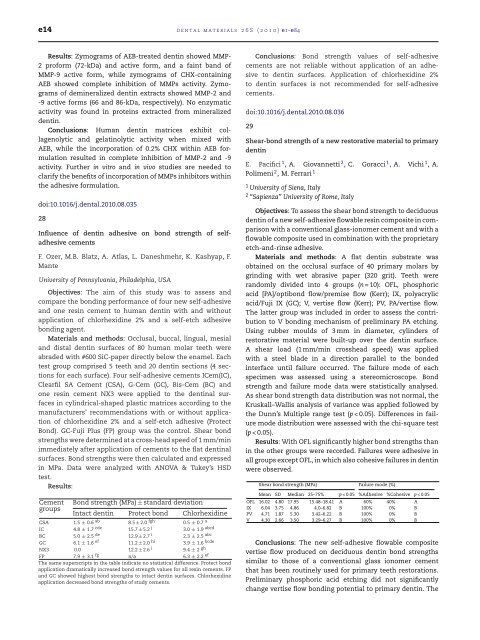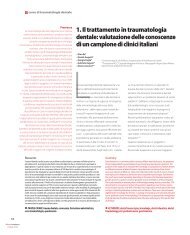Abstracts of the Academy of Dental Materials Annual ... - IsiRed
Abstracts of the Academy of Dental Materials Annual ... - IsiRed
Abstracts of the Academy of Dental Materials Annual ... - IsiRed
You also want an ePaper? Increase the reach of your titles
YUMPU automatically turns print PDFs into web optimized ePapers that Google loves.
e14 dental materials 26S (2010) e1–e84<br />
Results: Zymograms <strong>of</strong> AEB-treated dentin showed MMP-<br />
2 pr<strong>of</strong>orm (72-kDa) and active form, and a faint band <strong>of</strong><br />
MMP-9 active form, while zymograms <strong>of</strong> CHX-containing<br />
AEB showed complete inhibition <strong>of</strong> MMPs activity. Zymograms<br />
<strong>of</strong> demineralized dentin extracts showed MMP-2 and<br />
-9 active forms (66 and 86-kDa, respectively). No enzymatic<br />
activity was found in proteins extracted from mineralized<br />
dentin.<br />
Conclusions: Human dentin matrices exhibit collagenolytic<br />
and gelatinolytic activity when mixed with<br />
AEB, while <strong>the</strong> incorporation <strong>of</strong> 0.2% CHX within AEB formulation<br />
resulted in complete inhibition <strong>of</strong> MMP-2 and -9<br />
activity. Fur<strong>the</strong>r in vitro and in vivo studies are needed to<br />
clarify <strong>the</strong> benefits <strong>of</strong> incorporation <strong>of</strong> MMPs inhibitors within<br />
<strong>the</strong> adhesive formulation.<br />
doi:10.1016/j.dental.2010.08.035<br />
28<br />
Influence <strong>of</strong> dentin adhesive on bond strength <strong>of</strong> selfadhesive<br />
cements<br />
F. Ozer, M.B. Blatz, A. Atlas, L. Daneshmehr, K. Kashyap, F.<br />
Mante<br />
University <strong>of</strong> Pennsylvania, Philadelphia, USA<br />
Objectives: The aim <strong>of</strong> this study was to assess and<br />
compare <strong>the</strong> bonding performance <strong>of</strong> four new self-adhesive<br />
and one resin cement to human dentin with and without<br />
application <strong>of</strong> chlorhexidine 2% and a self-etch adhesive<br />
bonding agent.<br />
<strong>Materials</strong> and methods: Occlusal, buccal, lingual, mesial<br />
and distal dentin surfaces <strong>of</strong> 80 human molar teeth were<br />
abraded with #600 SiC-paper directly below <strong>the</strong> enamel. Each<br />
test group comprised 5 teeth and 20 dentin sections (4 sections<br />
for each surface). Four self-adhesive cements ICem(IC),<br />
Clearfil SA Cement (CSA), G-Cem (GC), Bis-Cem (BC) and<br />
one resin cement NX3 were applied to <strong>the</strong> dentinal surfaces<br />
in cylindrical-shaped plastic matrices according to <strong>the</strong><br />
manufacturers’ recommendations with or without application<br />
<strong>of</strong> chlorhexidine 2% and a self-etch adhesive (Protect<br />
Bond). GC-Fuji Plus (FP) group was <strong>the</strong> control. Shear bond<br />
strengths were determined at a cross-head speed <strong>of</strong> 1 mm/min<br />
immediately after application <strong>of</strong> cements to <strong>the</strong> flat dentinal<br />
surfaces. Bond strengths were <strong>the</strong>n calculated and expressed<br />
in MPa. Data were analyzed with ANOVA & Tukey’s HSD<br />
test.<br />
Results:<br />
Cement Bond strength (MPa) ± standard deviation<br />
groups<br />
Intact dentin Protect bond Chlorhexidine<br />
CSA 1.5 ± 0.6 ab 8.5 ± 2.0 fgh 0.5 ± 0.7 a<br />
IC 4.8 ± 1.7 cde 15.7 ± 5.2 j 3.0 ± 1.9 abcd<br />
BC 5.0 ± 2.5 de 12.9 ± 2.7 i 2.3 ± 2.5 abc<br />
GC 6.1 ± 1.6 ef 11.2 ± 2.0 hi 3.9 ± 1.6 bcde<br />
NX3 0.0 12.2 ± 2.6 i 9.4 ± 2 gh<br />
FP 7.9 ± 3.1 fg n/a 6.3 ± 2.2 ef<br />
The same superscripts in <strong>the</strong> table indicate no statistical difference. Protect bond<br />
application dramatically increased bond strength values for all resin cements. FP<br />
and GC showed highest bond strengths to intact dentin surfaces. Chlorhexidine<br />
application decreased bond strengths <strong>of</strong> study cements.<br />
Conclusions: Bond strength values <strong>of</strong> self-adhesive<br />
cements are not reliable without application <strong>of</strong> an adhesive<br />
to dentin surfaces. Application <strong>of</strong> chlorhexidine 2%<br />
to dentin surfaces is not recommended for self-adhesive<br />
cements.<br />
doi:10.1016/j.dental.2010.08.036<br />
29<br />
Shear-bond strength <strong>of</strong> a new restorative material to primary<br />
dentin<br />
E. Pacifici 1 , A. Giovannetti 2 , C. Goracci 1 , A. Vichi 1 ,A.<br />
Polimeni 2 , M. Ferrari 1<br />
1 University <strong>of</strong> Siena, Italy<br />
2 “Sapienza” University <strong>of</strong> Rome, Italy<br />
Objectives: To assess <strong>the</strong> shear bond strength to deciduous<br />
dentin <strong>of</strong> a new self-adhesive flowable resin composite in comparison<br />
with a conventional glass-ionomer cement and with a<br />
flowable composite used in combination with <strong>the</strong> proprietary<br />
etch-and-rinse adhesive.<br />
<strong>Materials</strong> and methods: A flat dentin substrate was<br />
obtained on <strong>the</strong> occlusal surface <strong>of</strong> 40 primary molars by<br />
grinding with wet abrasive paper (320 grit). Teeth were<br />
randomly divided into 4 groups (n = 10): OFL, phosphoric<br />
acid [PA]/optibond flow/premise flow (Kerr); IX, polyacrylic<br />
acid/Fuji IX (GC); V, vertise flow (Kerr); PV, PA/vertise flow.<br />
The latter group was included in order to assess <strong>the</strong> contribution<br />
to V bonding mechanism <strong>of</strong> preliminary PA etching.<br />
Using rubber moulds <strong>of</strong> 3 mm in diameter, cylinders <strong>of</strong><br />
restorative material were built-up over <strong>the</strong> dentin surface.<br />
A shear load (1 mm/min crosshead speed) was applied<br />
with a steel blade in a direction parallel to <strong>the</strong> bonded<br />
interface until failure occurred. The failure mode <strong>of</strong> each<br />
specimen was assessed using a stereomicroscope. Bond<br />
strength and failure mode data were statistically analysed.<br />
As shear bond strength data distribution was not normal, <strong>the</strong><br />
Kruskall–Wallis analysis <strong>of</strong> variance was applied followed by<br />
<strong>the</strong> Dunn’s Multiple range test (p < 0.05). Differences in failure<br />
mode distribution were assessed with <strong>the</strong> chi-square test<br />
(p < 0.05).<br />
Results: With OFL significantly higher bond strengths than<br />
in <strong>the</strong> o<strong>the</strong>r groups were recorded. Failures were adhesive in<br />
all groups except OFL, in which also cohesive failures in dentin<br />
were observed.<br />
Shear bond strength (MPa) Failure mode (%)<br />
Mean SD Median 25–75% p < 0.05 %Adhesive %Cohesive p < 0.05<br />
OFL 16.02 4.80 17.95 15.48–18.41 A 60% 40% A<br />
IX 6.04 3.75 4.86 4.0–6.82 B 100% 0% B<br />
PV 4.71 1.87 5.30 3.42–6.22 B 100% 0% B<br />
V 4.30 2.66 3.50 3.29–6.27 B 100% 0% B<br />
Conclusions: The new self-adhesive flowable composite<br />
vertise flow produced on deciduous dentin bond strengths<br />
similar to those <strong>of</strong> a conventional glass ionomer cement<br />
that has been routinely used for primary teeth restorations.<br />
Preliminary phosphoric acid etching did not significantly<br />
change vertise flow bonding potential to primary dentin. The



